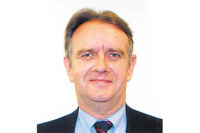Ask Dr. Dave
How can we ensure full cure when using a UV-cured coating/adhesive on irregularly shaped parts?
Dr. Dave shares tips on avoiding blind areas that do not cure completely on irregularly shaped parts.

You need to look at so-called “shadow curing” options. Most UV-cured systems are based on acrylates and methacrylates and cure free-radically by the decomposition of a photoinitiator. However, the light or UV radiation needs to flood or be focused on the adhesive material.
It is possible build in a secondary cure mechanism to cure the areas that do not get exposed to the UV radiation. Some allylic functional monomers will crosslink by exposure to atmospheric oxygen, and it is also possible to add isocyanate functionality to generate crosslinking by atmospheric moisture, in much the same way as one-component polyurethanes do. These shadow curing systems can cure in times ranging from less than an hour to several days, depending on the system and your specific requirements.
You will have to be careful about storage of these liquids to minimize exposure to the atmosphere. I have also had success in treating complex medical device parts by placing the parts in an enclosure with completely mirrored surfaces so the radiation gets reflected on to all of the part surfaces.
Any views or opinions expressed in this column are those of the author and do not represent those of ASI, its staff, Editorial Advisory Board or BNP Media.
Looking for a reprint of this article?
From high-res PDFs to custom plaques, order your copy today!






